Culture of United Arab Emirates
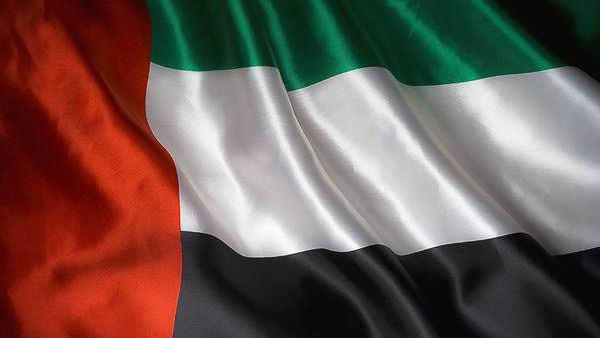
Culture Name
Emirati (in Arabic, Al-Thaqafa Al-Emaratiya )
Orientation
Identification. The United Arab Emirates (UAE) consists of the seven small emirates of Abu Dhabi, Dubai, Sharjah, Ras Al-Khaimah, Ajman, Umm Al-Qaiwain, and Fujairah, which were united as a federal state on 2 December 1971. Before the establishment of the oil economy in the early 1960s, two main orientations shaped traditional Emeriati culture: the nomadic desert-oriented Bedouins with small oasis farming within the broader context of the desert economy and culture, and the sea-oriented culture that revolved around pearling and sea trading. These subcultures were economically, politically, and socially interdependent, creating a common culture and social identity. The UAE shares significant aspects of its culture with neighboring Arab countries and the larger Arab culture.
Location and Geography. The UAE covers 32,278 square miles (83,600 square kilometers) and is located on the Arabian (Persian) Gulf. It shares land borders with Oman, Qatar, and Saudi Arabia. The seven emirates vary greatly in size. Abu Dhabi represents 85 percent of the land, and the smallest emirate is Ajman. Each emirate is named after its capital city, and Abu Dhabi City is the permanent capital of the nation. The inland area is mostly desert with a few oases, and the barren Hajar Mountains run through the country. The UAE has a dry climate with very high temperatures and humidity in the summer.
Demography. Relative to its size and oil wealth, the UAE has a small population, estimated at 2,624,000 in 1997. Before 1970, the local population was tiny (estimated at eighty-six thousand in 1961) and lacked most of the technical skills needed for a modern society. The commercial production of oil triggered rapid population growth as a result of an increase in the national population from improvements in diet, health care, and living standards and the importation on a large scale of mostly male foreign laborers. The latter factor has generated a dependence on expatriate labor; the UAE has become a multiethnic society, and Emirati nationals account for only about 20 percent of the population. This has created an imbalanced population composition in favor of males; in 1997, there were 1,755,000 males and 869,000 females.
About two-thirds of the immigrants are Asians, mainly from India, Pakistan, Iran, Sri Lanka, Bangladesh, and the Philippines. The remainder are Arabs, Europeans, and Americans.
Linguistic Affiliation. The official language is Arabic. Among the immigrant population, English, Hindi, Urdu, Farsi, and Filipino are spoken. English is the language of commerce.
Symbolism. National Day symbolizes one of the most successful experiments in unity in the modern Arab world. The main metaphor is that of the family, with the president referred to as a father. The colors of the national flag—green, red, white, and black—are shared with other Arab countries. Other cultural symbols are the falcon, camel, Arabian horse, pearling boat, coffeepot, and date palm. They are used to invoke a historical community that survived harsh conditions and now enjoys the benefits of unity and prosperity. These emblems appear on banknotes, coins, and stamps.
History and Ethnic Relations
Emergence of the Nation. Before 1971 the seven emirates were collectively known as the Trucial States, a name that originated from maritime agreements between the British and the leading sheikhs of the tribes inhabiting the southern coast between Qatar and Oman in the first half of the nineteenth century. The economic life of the UAE depended heavily on pearl diving and sea trade in the Gulf and
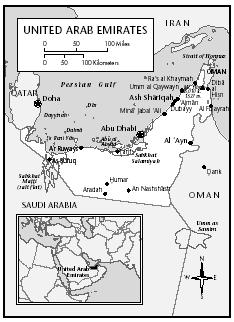
United Arab Emirates
the Indian Ocean. This led to the settlement of different ethnic groups from countries along the trade routes, such as Iran and India. Trade activities with east Africa led to the importation of Africans as laborers in the pearling industry in the late nineteenth century. The African and Iranian ethnic populations have been fully integrated as citizens.
Urbanism, Architecture, and the Use of Space
Before 1960, the only settlements were small towns and villages. Oil resources have enabled massive modernization. Towns have been transformed from mud-walled communities into commercial capitals integrated in the global economy. Because of the small population and harsh desert interior, 80 percent of the population lives in the coastal capital cities, leading social scientists to describe them as city-states.
Urbanization has been characterized by unparalleled growth. Abu Dhabi is one of the most modern cities in the world. UAE cities have been heavily influenced by the global city type. Dominant urban features include skyscrapers in the commercial city centers, multistory residential buildings, large shopping malls, wide boulevards, an extensive network of highways, and sprawling new suburbs.
The cities have a multiethnic composition, with segregated housing areas for nationals and the immigrants. Housing is subdivided further according to class, social power, ethnicity, and nationality.
To create a balance between their global and local aspects, in municipalities have adopted policies projecting Arab-Islamic architectural design, particularly arched windows, gates, and decorative stucco. Recently, more urban settings have exhibited decorative designs with local themes related to the national heritage. Preservation of the urban heritage also is seen in the renovation of old forts, palaces, souks (marketplaces), and mosques. Date palm trees, symbols of the local culture, have been planted extensively along city roadsides.
Food and Economy
Food in Daily Life. Before the 1960s, food consisted mainly of fish, rice, bread, dates, yogurt, homegrown vegetables, and meat from sheep, goats, and camels. The diet has improved in quality and variety, with modern supermarkets offering imported foods.
Lunch is the main family meal and is eaten at home at around two o'clock. It usually consists of fish, rice, meat, and a vegetable dish. Many Emiratis prefer the traditional style of eating with the right hand. There are strict Muslim taboos against pork and alcohol, and meat must be slaughtered according to the Islamic halal method.
Emiratis are known for their hospitality; they feel honored when receiving guests and socializing with friends and relatives. Guests are welcomed with coffee and fresh dates. Incense is passed around so that guests can catch the fragrance in their headwear. With the immigrant population have come restaurants offering a wide variety of ethnic foods, and fast-food restaurants have also become popular.
Basic Economy. Income is among the highest in the world, but there are large differences between the emirates, with Abu Dhabi, Dubai, and Sharjah producing the most oil. The other emirates have benefitted from oil wealth through the federal welfare system and employment in state institutions.
With declining oil prices, the government has attempted to diversify the national economy. This has led to the growth of industry, construction, commerce, free trade zones, transportation, tourism, farming, fisheries, and communications. The rapid development of these sectors has reduced the nation's dependence on oil. In 1998, the gross domestic product was estimated at $45,590 million, 70 percent from the nonoil sector.
The national currency name is called the Emirian Dirham.
Major Industries and Trade. The UAE is the third largest exporter of crude oil and gas in the Gulf. It is a member of the Organization of Petroleum Exporting Countries (OPEC).
Division of Labor. Citizens account for 10 percent of the total labor force. Almost all nationals (99 percent) work in the state sector because of the attractive benefits and are employed mainly in nontechnical jobs in education, the army, the police, and the civil service. They also own all Emirati businesses. Immigrants are employed in both the public and private sectors in manual, technical, and professional occupations.
Social Stratification
Classes and Castes. Emirati society is divided into two social categories: the nationals ( Al-Muwateneen ) and the foreign immigrants, referred to as the incomers ( Al-Wafedeen ). Citizens are subdivided into four main social classes: (1) the ruling sheikhly families, whose members hold the highest political positions and power and have immense wealth and prestige, (2) the merchant class, known as al-tujjar , traditionally pearling merchants who now sell international consumer goods, (3) the new middle class, represented by increasing numbers of professionals who have benefitted from free state education, and (4) the low-income groups, represented by newly settled Bedouin nomads and former pearl divers and oasis farmers.
Among the immigrants there are hierarchical groups that receive different economic and social rewards: (1) top professionals and technocrats with international contracts, who earn high salaries and other benefits, (2) middle-range professionals such as school teachers, skilled technicians, and company salesmen, and (3) low-paid semi-skilled and unskilled workers, primarily Asian. In general, nationals are a privileged minority, and benefit from state laws and business regulations.
Symbols of Social Stratification. The symbol of a male national as a distinct social category is seen most visibly in the traditional dress of a white robe ( kandoura ) and white head cloth ( ghutrah ) with a black rope ( aqal ). Men grow short beards and mustaches.
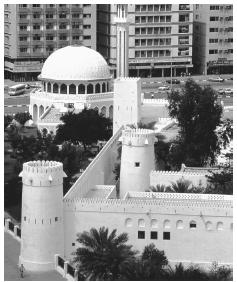
An old fortress surrounded by modern buildings in Abu Dhabi. After 1960, mud-walled communities transformed into commercial centers.
Women wear long dresses with a head cover ( hijab ) and black cloak ( abayah ).
Political Life
Government. The UAE has a federal government that is made up of several organs: the president and his deputy, the Supreme Council, the cabinet, the Federal National Council, and an independent judiciary with a federal supreme court. The Supreme Council has both legislative and executive powers and includes the rulers of the seven emirates. The cabinet consists of ministers drawn mainly from the ruling families of the emirates.
Leadership and Political Officials. The fact that the traditional tribal system of government each emirate was based on similar political principles facilitated the establishment of the UAE. Hereditary dynastic family rule still operates in each emirate as a local government system under the umbrella of the federal system. Members of the ruling families occupy the most important positions in their political administrations. While the political system continues to retain some of its traditional values at formal and informal levels, it has been able to keep pace with economic and social change. The sheikhs are highly regarded for performing the dual roles of modernizers and guardians of the cultural heritage. They still have traditional majlis where citizens have access to their leaders.
Social Welfare and Change Programs
The development of the infrastructure has been impressive. The welfare system offers womb-to-tomb free state services for all nationals, including high-quality health care, education up to the tertiary level, social security, family allowances, subsided electricity and water, and housing for low-income groups. This is a major way of distributing oil wealth among the national population. The immigrant population also benefits to some extent, particularly in regard to medical care.
NonGovernmental Organizations and Other Associations
There were 103 Associations of Public Benefit in 1999, serving interests of many groups and identified with heritage preservation, immigrant communities, professional groups, culture, women, religion, sports, and general humanitarian services. Their role is seen as complementary to that of governmental institutions.
Gender Roles and Statuses
Division of Labor by Gender. Modern economic roles and social status reflect both change and continuity for women. Schools and universities are segregated, and levels of enrollment of girls and their performance are impressive. In higher education, female students outnumber males two to one. However, women's participation in the labor force remains one of the lowest in the world at 6 percent in 1990. In spite of new employment opportunities, most women opt for marriage and raising children. UAE society places a high value on those roles. Conservative cultural attitudes lead women to seek jobs that do not involve mixing with men or commuting far from home. Subsequently, most women are employed in education, health, and civil service.
The Relative Status of Women and Men. Official statements affirm that men and women have equal rights and opportunities to advance themselves and the nation, yet patriarchy as a generalized ideology is still visible in social life. Men continue to receive employment preferences in high state administration and private businesses. Women do not play a significant role in politics and religious life, as these areas are considered male domains.
Marriage, Family, and Kinship
Marriage. Arranged endogamous marriage within the kinship (tribal) units was the preferred pattern in the preoil period, but this pattern has changed somewhat. Individuals now have greater choice, yet many nationals still prefer arranged marriages. Emiratis are strongly discouraged from marrying nonnationals, and a young man receives $19,000 from the Marriage Fund if he marries a national. As prescribed by Islam, a man is allowed up to four wives, but most men have only one wife.
Domestic Unit. The traditional household unit of the extended family has been undermined, as over 80 percent of national households live as nuclear families in their own houses. Large families are encouraged by the state as a national policy, and family size is six to eight children. The husband's authority is declining, while the wife is gaining importance as a mother and the manager of the domestic unit. On average, each household employs two live-in domestic servants, usually Asian.
Kin Groups. UAE society is family- and kin-oriented. Tribal kinship units play a significant role in social identification and one's standing in the community. Most families prefer to live in the same neighborhood as their kin.
Socialization
Child Rearing and Education. Children are showered with care, affection, and physical contact. They are raised to be respectful toward their parents and elders and grow up to be skilled in interaction with a large number of relatives. Up to age 5, a child is referred to as jahel ("the one who does not know"), and there is a tolerant attitude toward children's behavior. Most families employ maids to share child caretaking, and this has introduced a foreign cultural element to child socialization, although a maid's influence is viewed as negative. The school system has undertaken a greater role in children's socialization, significantly reducing the family's role in this process.
Higher Education. The government views higher education as a major instrument for development. The UAE has one of the highest ratios of students entering higher education in the world. There are seven universities and eleven higher colleges of technology.
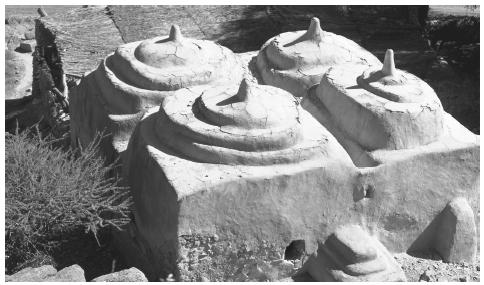
An old mosque in Fujairah. Islam is the dominant religion in the UAR, so mosques can be found everywhere.
Etiquette
Social customs are shared throughout the Gulf Arab countries. An Islamic greeting ( al-salam alaykom )is the most appropriate, and men follow this with a quick nose-to-nose touch while shaking hands. Women greet each other by kissing several times on both cheeks. Men normally do not shake hands with women in public. It is customary to ask about the health of a person and his or her family several times before beginning light conversation. Refreshments usually are served before serious matters are discussed.
It is customary not to use first names but to say "father or mother of (oldest son)." Respect and courtesy are shown to elders, and in their presence young men are expected to listen more and speak less. Sex segregation is still evident in social life. Men are entertained in majlis (large living rooms, often with a separate entrance), while women entertain friends in the home. It is customary to take off one's shoes before entering a private house.
Emiratis stand close to each other when interacting. It is acceptable for men or women to hold hands. The presence of many ethnic groups has led Emiratis to be tolerant of other social customs, yet they remain conscious of their own customs as markers of cultural identity.
Religion
Religious Beliefs. Islam dominates all aspects of life. Most Emiratis are members of the Sunni sect. Matters relating to marriage, divorce, inheritance, economics, politics, and personal conduct are affected by Sharia (Islamic) law.
Emaritis are tolerant toward other religions, and immigrants of other faiths are allowed to have their own places of worship. Large numbers of Asian and Arab immigrants also follow Islam.
Rituals and Holy Places. The main Muslim religious ritual is prayer five times a day. This requires wodou (ablution) for purification. Usually people go to the nearest mosque or pray at home. The rituals involved in the pilgrimage ( Haj ) to Mecca are the most elaborate. One must remove the shoes before entering a mosque. In large mosques, there are separate areas for women.
Medicine and Health Care
Before 1960, there were few hospitals, and the population relied on traditional folk medicine. Cautery, bloodletting, and the use of herbs were common, and a religious teacher ( muttawe ) dealt with cases of mental illness. Life expectancy was around forty-five years. Today Emiratis have a free modern
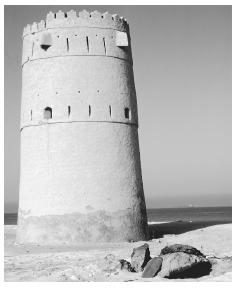
An ancient watchtower on the coast of the United Arab Emirates.
health care system with numerous hospitals, primary health care centers, and private clinics staffed primarily by immigrants. With improved diet and health care, life expectancy is now seventy-two years, and there has been a reduction in infant mortality. The extended family provides its sick members with support in the form of frequent hospital visits, and traditional medical practices are still used to deal with mental illnesses.
Secular Celebrations
The UAE national day, 2 December, is the most important secular celebration. Cities are decorated with colored lights, and folklore troops perform in heritage villages. 1 January is a holiday but is not celebrated by nationals. Expatriate communities celebrate their own religious and secular holidays.
The Arts and Humanities
Support for the Arts. The state generously supports writers, painters, actors, and folk dancers. Sharjah is particularly active in promoting culture and was chosen by UNESCO as the Arab Cultural Capital in 1998.
Literature. The oral tradition remains strong, particularly storytelling and poetry, and most state events are accompanied by poetry readings. Written literature is increasing in popularity.
Performance Arts. Conservative elements of the society still impede women's participation in performance arts. In 1999, the first college for theater arts opened in Sharjah. Emiratis rely on theater and television programs produced in other Arab countries.
Bibliography
Abdul Rahman, Abdullah. The Emirates in the Memory of Her Sons (in Arabic), 1990.
Abdulla, Abdul Khaliq, et al. Civil Society in the United Arab Emirates (in Arabic), 1995.
Al-Alkim, Hassan. The Foreign Policy of the United Arab Emirates , 1989.
Al-Faris, Abdul Razzaq. Higher Education and the Labor Market in the UAE (in Arabic), 1996.
Al-Gurg, Easa. The Wells of Memory , 1998.
Al-Hassan, Yusuf. The Welfare State in the United Arab Emirates (in Arabic), 1997.
Al-Mur, Mohammad. National Aspirations: Essays about the Emirates (in Arabic), 1997.
Al-Otaiba, Mana. Petroleum and the Economy of the United Arab Emirates , 1977.
Codrai, Ronald. The Seven Sheikhdoms: Life in the Trucial States before the Federation of the United Arab Emirates ,1999.
Corderman, Anthony. Bahrain, Oman, Qatar and the UAE , 1997.
Crystal, Jill. Oil and Politics in the Gulf: Rulers and Merchants in Kuwait and Qatar , 1990.
Drake, Diana. Discovery Guide to the United Arab Emirates , 1998.
Dubai: A Pictorial Tour , 1999.
Dyck, Gertrude. The Oasis: Al-Ain, Memoirs of Doctora Khalifa , 1995.
Encyclopedia of the Emirates , vol. 1: Dubai , 1993–1994.
Facey, William, and Gillian Grant. The Emirates by the First Photographers , 1996.
Ghobash, Moaza. Immigration and Development in the United Arab Emirates: A Sociological View (in Arabic), 1986.
Heard-Bey, Frauke. From Trucial States to United Arab Emirates , 1996.
Kay, Shirley. Emirates Archaeological Heritage , 1986.
——. Land of the Emirates , 6th ed., 1992.
Khalaf, Sulayman. "Gulf Societies and the Image of Unlimited Good." Dialectical Anthropology 17: 53–84, 1992.
Matthew, Jane. UAE: A MEED Practical and Business Guide , 5th ed., 1999.
Mohammed Al-Fahim. From Rags to Riches , 1995.
National Atlas of the United Arab Emirates , 1993.
Nowell, John. Now and Then: The Emirates , 1998.
Owen, Roger. "Migrant Workers in the Gulf." Minority Rights Report 68: 1985.
Progress of UAE Women . Association of Popular Heritage Revival.
Robinson, Gordon. Arab Gulf States , 1996.
Spectrum Guide to the United Arab Emirates , 1998.
Studies in Emirates Society (in Arabic), 1997.
Thesiger, Wilfred. Arabian Sands , 1959.
UAE in Focus: A Photographic History of the United Arab Emirates , 1998.
Zahlan, Rosemarie. The Making of Modern Gulf States , 1989.
